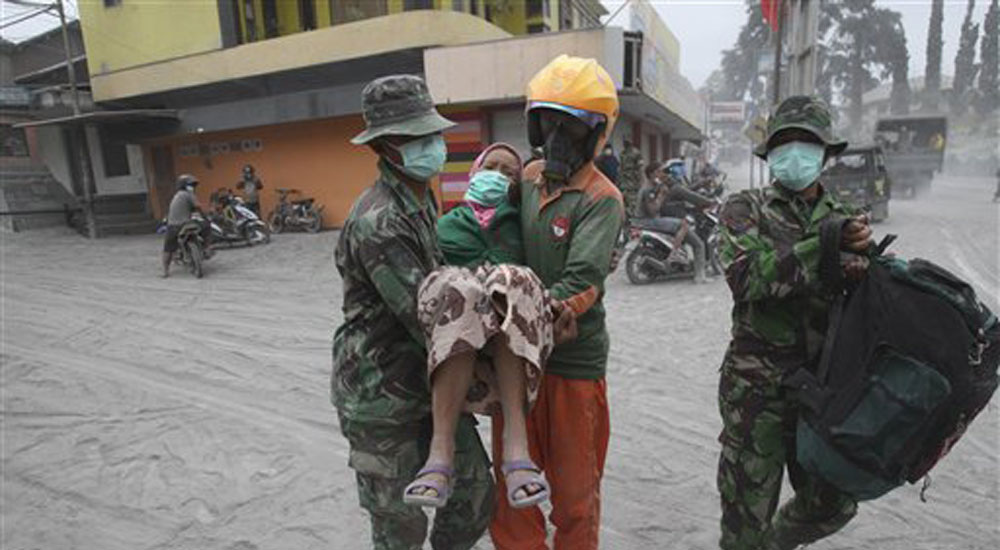Indonesian volcano brings life as well as death

Soldiers and rescuers carry a woman to a truck for evacuation following an eruption of Mount Kelud, in Malang, East Java, Indonesia, Saturday, Feb. 15, 2014. The powerful volcanic eruption on Indonesia’s most populous island blasted ash and debris 18 kilometers (12 miles) into the air Friday, forcing authorities to evacuate more than 100,000 and close seven airports. AP
SIDOMULYO, Indonesia — The ash and debris that Indonesia’s Mount Kelud blasted from its belly brought death and misery, and disrupted international air traffic. But for many of the millions of people cleaning up in the wake of the explosive eruption, it was also a money earner and a shot of life for their crops.
“This is a blessing of the disaster,” said Imam Choiri, a farmer who was scraping up the ash from the road to use as fertilizer on his small vegetable plot a few kilometers from the crater of the rumbling mountain. Choiri said locals believe the ash helps drive away pests from crops.
The eruption of the 1,731-meter (5,680-foot) -high mountain on Java island late Thursday was one of the most dramatic to hit Indonesia in recent years, with ash falling as far as 600 kilometers (370 miles) away.
Four people, including a 97-year-old woman, were killed when the roofs of their homes caved in under the weight of ash. More than 100,000 people were evacuated to temporary shelters.
On Saturday, scientists said Kelud’s activities were dying down, in line with its reputation as a mountain that blows its top dramatically but then quickly settles down for another 10 years or so. But authorities warned that water from its crater, along with rain, could bring deadly landslides of fresh ash and rocks down river beds into villages and valleys.
Article continues after this advertisementArmy troops enforced a ban on people returning to houses within 10 kilometers (6 miles) of the volcano, but many people sneaked back to check on livestock and clean up. Authorities were finding it hard to prevent people from returning, given the money farmers stand to lose by staying away, and said about 56,000 people remained in 89 shelters.
Article continues after this advertisement“Our cows need to be milked. If they aren’t, they can get sick and die,” said Marjito, who was riding on a motorbike with his wife to his village around 5 kilometers (3 miles) from the crater.
“We have so much work to do, including running and hiding from security officers,” said his wife, Dinayah. Like many Indonesians, both go by a single name.
Volcanic ash and debris are also prized in the building industry because they make especially strong cement, and sand diggers can charge almost twice as much per load than they can for regular sand. Scores of diggers were collecting the fresh, easy-to-dig sand, packing the windfall into bags or onto trucks.
“Kelud is a valuable source of livelihood to me and my family,” Harjito Huda, a sand miner from Ngancar village, said.
Transportation Ministry spokesman Bambang Ervan said that the Juanda international airport in the country’s second-largest city, Surabaya, resumed operation late Saturday along with three others in Malang, Semarang and Cilacap.
A total of seven airports on Java — Indonesia’s most densely populated island and home to more than half of the country’s 240 million people — had been closed because of ash on the runway and on planes.
Three other airports in Bandung, Solo and Yogyakarta are scheduled to reopen later Sunday or Tuesday at the latest, Ervan said. The Darwin, Australia-based Volcanic Ash Advisory Center informed that the conditions in Indonesia are safe for airlines, he said.
President Susilo Bambang Yudhoyono left the capital, Jakarta, on a 10-hour train trip to East Java to visit the devastated areas.
A massive cleanup was underway in the region, where millions of homes received ash fall. Police and soldiers used water cannons to clear roads that in places were covered in up to 10 centimeters (4 inches) of white ash. Supporters of political parties campaigning for April elections, wearing party colors, also chipped in and gave out food, seeking to win votes on the back of their assistance. Many people were wearing face masks to protect against the dust that remained in the air.
Kelud’s last major eruption was in 1990, when it spewed out searing fumes and lava that killed more than 30 people and injured hundreds. In 1919, a powerful explosion that reportedly could be heard hundreds of kilometers away killed at least 5,160 people.